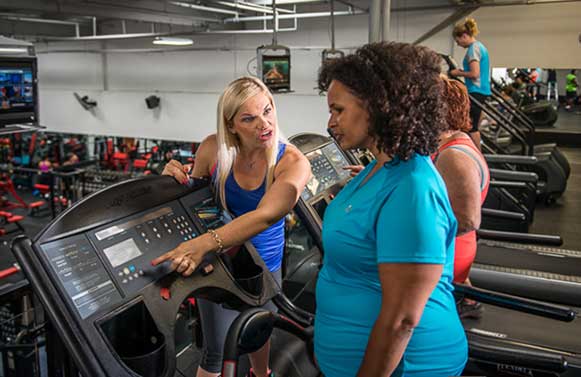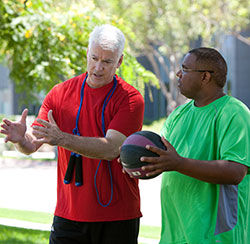
Despite the fact that healthy living and the battle against the obesity epidemic are staples of the news media, there is actually a growing bias against individuals who are deemed overweight or obese. In fact, the number of people who feel they are discriminated against because of their weight is similar to that seen with more scrutinized and criticized forms of stereotyping such as age and race discrimination. Weight-based discrimination is all too common, and too commonly accepted by society.
People-first Language
For quite some time, people-first language has been used by the media and members of the healthcare community to sensitively discuss certain conditions—“a person with diabetes” vs. “a diabetic,” or “a person with schizophrenia” vs. “a schizophrenic” (Obesity Action Coalition, 2014). This type of language avoids labeling a person as his or her disease, and has only recently become more commonplace when discussing obesity. Phrases like “the obese man” can be dehumanizing and demoralizing. Instead, you can say “the man with obesity.” This type of phrasing draws attention to the fact that obesity is a disease, not a personal failure or shortcoming.
When working with clients with obesity, you should refer to obesity or body weight scientifically with body mass index (BMI) or body-composition descriptors, or by using terms like “weight” or “excess weight,” rather than terms like “weight problem,” “fat,” or “severely obese.”
It might not be surprising to hear that weight is the number one target for bullying among children—more so than gender or sexual orientation (Puhl and Latner, 2007). What may surprise you, though, is the fact that weight-related biases continue throughout life, even among healthcare professionals, with one-third of physicians acknowledging that patients with obesity trigger negative perceptions and responses (Puhl and Brownell, 2012; Klein et al., 1982). In fact, only three patient characteristics yielded negative feelings among physicians more often: drug addiction, alcoholism and mental illness. These negative attitudes may lead individuals with weight issues to avoid healthcare, which means that the language and biases of the doctor can cause those patients who are most in need of their care to stop pursuing treatment.
This phenomenon undoubtedly carries over to the fitness environment as well. As a health and fitness professional, you likely work with individuals who are affected by obesity, and desire to inspire them to repeatedly return to the gym and adopt a more active, healthy lifestyle. With that in mind, you can learn to optimize your language and assessment process to reduce the stigma of excess weight and prevent weight bias, using empathy to motivate your clients to become more physically active.
Language Matters
Changing the way you communicate may seem like a difficult process, but it’s really pretty simple, according to Jonathan Ross, ACE Certified Personal Trainer and owner of Aion Fitness: “Put yourself in the client’s shoes and think about how you’d like to be spoken to.”
The trouble that many health and fitness professionals have with effectively communicating with an individual who is affected by obesity is that the client’s experiences with movement and exercise are often so different from that of a personal trainer or health coach. The key, says Ross, is to “keep in mind that ordinary things are no longer ordinary once you reach a certain weight.” For example, gait mechanics are different for people who carry a lot of excess weight, which makes the act of walking a sometimes-exhausting task.
“It is important to remember,” says Ross, “that these clients are often tired all day long as the result of so-called basic movements, like climbing stairs or being on their feet at work.”
There are two phrases in particular that Ross recommends you avoid at all costs when working with a client with a weight issue:
“Just”
As in, “You can just walk on the treadmill for 10 minutes to get the blood pumping.”
There may be no such thing as “just walking” for a particular client, as individuals who are carrying excess weight may struggle to walk at a constant pace for more than a few minutes. The fact that it’s easy for the fitness professional does not mean it’s easy for every client.
“If you can’t…”
As in, “If you can’t handle the elliptical machine, then we’ll stick to the treadmill for now.”
This type of compromising tone is terrible, says Ross. Instead, these clients must be congratulated and celebrated for taking part in physical activity. The most important motivator for beginning exercisers (regardless of their body weight) is a positive, enjoyable experience that helps them think about physical activity in a new, positive light. Reminding them that they can’t do certain things can be tremendously demotivating.
On the flipside of this negative, demotivating language is excessive enthusiasm, which can be equally detrimental. New clients who are trying to address concerns with their weight and overall health are often turned off by perpetually upbeat trainers who may seem blind or indifferent to the clients’ struggles. Instead, Ross recommends you be even with your tone of voice and communicate somewhat dispassionately when working with these clients.
Performing Assessments
The assessment process, particularly when working with a client with a weight challenge, should begin with an extensive conversation. Ross recommends building this conversation around the client’s answer to the following question: “How do you spend your time physically?” Explore what movements are required for the client to perform his or her job and activities of daily living, as well as what types of activities the client takes part in during his or her leisure time or for recreation.

It is important to avoid having certain assessments set in stone when working with new clients. Assessments such as ventilatory threshold testing, skinfold measurements and the body-weight squat test may scare off many potential clients before they even get started. In addition, these assessments will likely not yield very much usable information for a trainer or coach developing an entry-level program for a client affected by obesity.
Many clients who are of an unhealthy weight will not want to perform movements or take measurements that will only serve to remind them that they are out of shape or carrying excess body weight. That said, you should try to nudge reluctant clients toward performing some form of assessment to establish a baseline for comparison later on in the program—which brings us back to the importance of that initial assessment conversation.
If a client tells you that she likes to go for short walks after dinner but sometimes struggles with the hills in her neighborhood, you can design an assessment that measures her hill-climbing ability on the treadmill. Have her choose a pace and incline with which she is comfortable and record her perceived exertion levels and heart rate. Then, a few months later, you can repeat this process to help illustrate the progress made in a personally relevant activity that will directly improve her quality of life. Most clients will come to appreciate the ability to see their progress through this type of “before and after” comparison.
This type of personalized testing design is just one way to use your creativity to take some of the potential sting and intimidation out of assessments. For example, many clients find the process of having their circumference measurements taken to be an unpleasant and demotivating experience. To help alleviate their uneasiness, consider using an alternative technique that eliminates the numerical values that many clients find so upsetting. For example, you can use a ribbon to measure circumferences, cutting the ribbon at the appropriate lengths. Then, when these measurements are repeated later on in the program (and the ribbons are noticeably shorter), you and your client have a very clear visual representation of the progress made.
Conclusion
One key issue of which all health and fitness professionals should be mindful is the use of short- versus long-term goals when working with clients with obesity. Many athletic clients will be working toward long-term objectives, using shorter-term goals as steppingstones on the journey. Individuals with obesity do not typically thrive with this type of process or language, according to Ross. “When every day is a challenge, long-term goals don’t matter as much,” he says. The goal for most clients with weight issues is to “feel better right now,” not to improve performance or even address some far-off health-related goal like lowering their cholesterol or blood pressure.
For this reason, health and fitness professionals should work with these clients to find ways to address their immediate concerns and improve their ability to perform everyday tasks that are important to them—such as the hill-climbing example described earlier. Remember, the point is to improve overall quality of life. Seeing results is a strong driving force behind any client’s motivation to start and maintain a physically active lifestyle, and that, as always, should be the ultimate goal of any fitness program.
References
Klein, D. et al. (1982) Patient characteristics that elicit negative responses from family physicians. Journal of Family Practice, 14, 881–888.
Obesity Action Coalition (2014). People-First Language for Obesity.
Puhl, R. and Brownell, K.D. (2012). Bias, discrimination, and obesity. Obesity Research, 9, 12, 788–805.
Puhl. R.M. and Latner, J.D. (2007). Stigma, obesity, and the health of a nation’s children. Psychological Bulletin, 133, 4, 557–580.
Additional Resources
Institute of Medicine’s Obesity Solutions Roundtable
Obesity Action Coalition
Puhl, R. and Kyle, T. (2014). Pervasive bias: An obstacle to obesity solutions. Commentary, Institute of Medicine, Washington, DC.





 by
by 



